
15 minute read
Swift weather? ............................................................Adam Gretton & Jonny Rankin
Adam Gretton, Jonny Rankin & Phil Brown
Swift Weather?
What were the chances of two megaswifts turning up in the UK within less of a fortnight of each other this June?
Slim would probably have been your gut reaction. But you’d be wrong because, counter intuitively, there is good reason to say it is surprisingly likely (leaving aside the fact that it has already happened). In short both species have not only the capability, but also the inclination to undertake such long distance journeys. Born to fly First, and superficially, swifts’ aerodynamics and physique fit them perfectly for an aerial existence. Also, they not only feed exclusively on the wing, but have the capacity to sleep as well, hence their ability to be on the wing all year round. So flying considerable distances is not a problem.
Pacific Swift Second, these two species (the Pacific Swift and White-throated Needletail) are actually known for their long-distance flying. Even the Common Swift is reported to undertake mass movements around North European depressions, often entailing a round trip approaching 2000 km, just to feed. Long-distance flight is thus common. Third, in habitat terms the swifts are generalists. Wherever insects occur they can exist and, as a consequence, the swift family is very widely distributed.
Fourth, possibly because they can so easily roam, swifts display a proclivity for vagrancy (after all it’s how the family populated so much of the planet), not uncommonly pitching up thousands of kilometres away from their home territory in response to variable insect prey abundances and/ or adverse weather conditions.
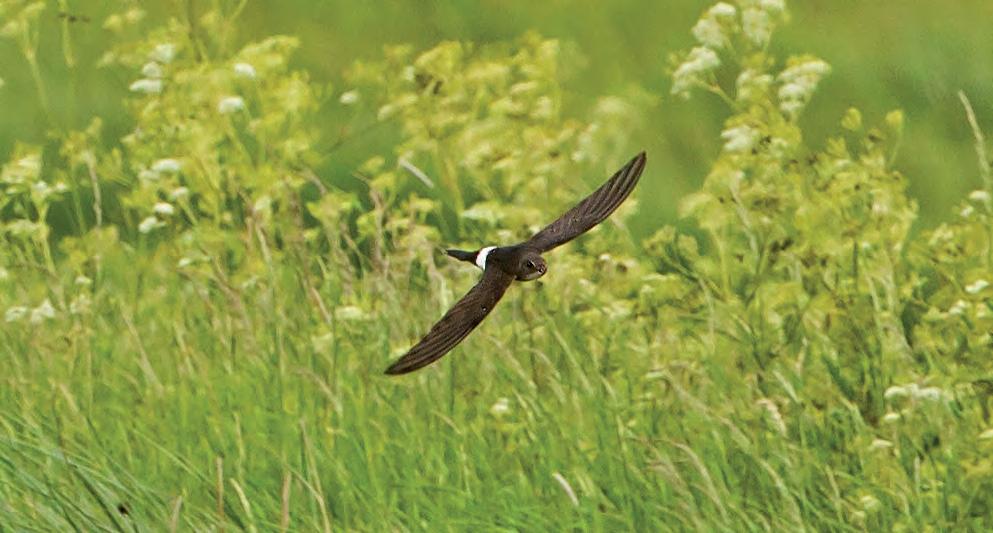
Distance no object As previously noted, the nominate races of Pacific Swift and White-throated Needletail have both been dubbed “long-distance migrants” by the ‘Handbook of the Birds of the World’ (HBW). Both species also winter in the south around Australia, returning north and east in the spring to a joint breeding area that stretches from India in the west through to China and Siberia in the east. Normally they’d complete this journey between April and June, depending how far north they’d travelled, so both of these potential overshoots could have begun their journey at about the same time towards the end of May. In fact, according to Ian Newton, overshooting tends to be common amongst spring migrants. Swifts are known to migrate speedily - for example Alpine Swifts have been recorded covering 500 km in a single day (and the Common Swift in excess of 400 km). So both of these swifts could have begun to overshoot their spring migration routes in mid to late-May and realistically covered the intervening 6 - 10,000 km in time for the Needletail to turn up on the Hebrides by early June and the Pacific be seen at Trimley by the 20th, via Spurn on the 12th and possibly even earlier at Bawdsey (in late May). Weather the trigger? But adverse weather could have had a part to play too. In Harrier #167 it was speculated as to whether the Boyton Sandhill Crane had been spirited across the Atlantic courtesy of the tail-end of Hurricane Katia. In the same issue it was also conjectured that the earlier Finnish/Estonian Sandhill may have been a victim of Hurricane Irene, that preceded Katia, when it skirted the US eastern seaboard in late August 3 . Weather could well have had an impact on the two swifts as well. Rather than flying due west across much of the Eurasia it would be more logical for the birds to have continued north from Siberia and take the shorter trans-Polar route to northern Europe (while the trans-Polar route might at first sight be seen as ‘more attractive’, as it is approaching 4000 km shorter than the flight westward across the Asian/European land mass, the presumed dearth of feeding opportunities en route may however have deterred its use). So this concurrence of swifts in the north and east of the UK was perfectly possible but could there have been a trigger event that led to it? This following research by Adam Gretton is highly suggestive:
White-throated Needletail
3 Ian Newton has attested to the capacity for eastward-moving depressions (the usual aftermath of hurricanes/tropical storms) to carry North American birds to Europe.

There has been much speculation on whether both eastern visitors may have been brought to the UK on the same weather system, as the needletail could have arrived ten days or more before we [i.e. Mark Cocker and Adam Gretton] connected with it, simply going unnoticed in the huge unwatched areas of the Highlands & Islands. Both nest in central Siberia and further east, so they may have been brought here by similar weather conditions. Neither Jonny [Rankin] nor I have the expertise to analyse the [Siberian] weather charts from late May/early-mid June, but if any readers can help we would be very glad to hear from you. What I have been able to deduce from information online is that there was some exceptional weather in west Siberia in early June 2013. On 2nd June there was heavy snow in Kemerovo, a city only 55N, which is used to warm summers. Events in Nadym, further north, made the BBC weather round-up two weeks later. On 12th June the temperature reached 28C, but just two days later an Arctic cold front reduced this to zero, with heavy snow. Could this very unusual circumstance have played some part in pushing these two strays westwards, perhaps in combination with other factors? The exceptional Siberian summer continued in July and August, with huge fires followed by floods in east Siberia.
To be honest we will never be certain what triggered the birds to make for the UK, but appear they did. So enjoy these two accounts of their arrival on either side of the country:
Pacific Swift over Trimley Field comparison - Pacific (right) note the tail (in other shots deeply forked), longer wings, slimmer and more scythe-shaped and paler shade of brown
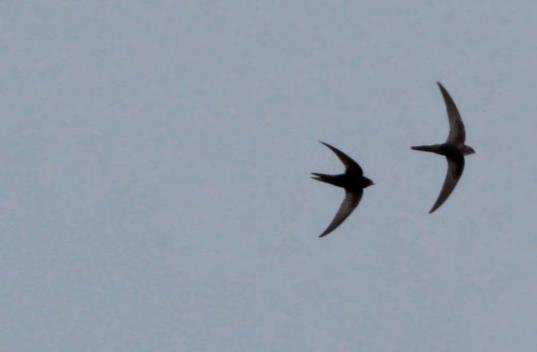
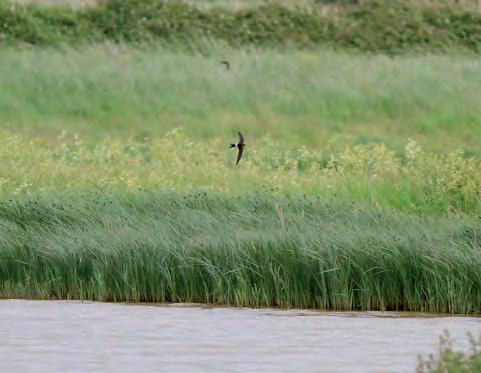
Act One, Trimley, 15-16th June – Jonny Rankin I was delighted when fellow West Suffolk birder Adam [Gretton] got in touch and asked if I was up for co-authoring an article for the Harrier. It was great to put a name to the ‘other West Suffolk birder’ who found the Needletail. Firstly, I would like to extend my congratulations to both Adam and Mark Cocker on the finding of such a mega. Secondly I’d like to make it clear that as sad as its demise is, it is a common fate of many vagrant birds and, further to this, wind turbines are just one of many man-made obstacles to wildlife. Accordingly I have little sympathy for those only concerned that they missed another ‘tick’ as opposed to wild birds’ welfare. So, concentrating on the positives, what an exhilarating find! I can relate to Adam and Mark’s experience following my own of finding of a (albeit slightly less) mega swift at the other end of the country, in Suffolk. The finder’s account for this Swift has been published a couple of times, once on the Birding Frontiers website (http://tinyurl.com/kv63bpw) and thereafter a more sober account in the August, 2013 issue of Birdwatching Magazine. To summarise: with the girlfriend in Ipswich for the day I took the opportunity to do one of my favorite walks in the county; Levington Marina to Trimley Marshes SWT and back. There are always birds to be seen and it’s a great walk for both the dog and me. I think most Suffolk birders were on ‘Swift alert’ at this time following a record of a ‘white-rumped swift’ at Bawdsey at the end of May, the resulting blurred photo was inconclusive but certainly exciting! Some observers are now apparently confident that the bird at Bawdsey was a Pacific Swift, having got better views than those captured on the images. Whether the earlier bird was the real deal or a convincing aberration, it was rewarding to locate the real deal a couple of weeks later, on Saturday 15th June to be exact. The rest is, as they say, history. The Pacific Swift was well watched, photographed and discussed. I believe most Suffolk listers connected over its two-day stay and I have Twitter friends from Yorkshire and even Scotland who connected on the Saturday the news broke! I am genuinely pleased so many were able to connect and the finding still has a really celebratory feel about it, I am proud I was in the right place at the right time and able to give affirmative identification.

In terms of drawing parallels between the findings of the two-mega swifts consecutively with West Suffolk birders key to each, well I am sure it is just pure luck. Weather is something that certainly played a part in my finding the Pacific as strong winds ensured the gathered Swifts were low over the floods and reed beds allowing for easy checking. This doesn’t give any insights to how or when the bird arrived on these shores, but we do know it was sighted in both Yorks and Lincs before settling in Suffolk for the weekend. I understand it was last seen in Spain! Luck and diligence Putting luck and the weather aside the only commonality is the West Suffolk connection; perhaps the inland patching engrains more of a ‘finders’ aptitude? Coastal birding at the known ‘hotspots’ is easy with so many eyes and predetermined scrapes and washes to check and bird headland bird observatories are the avian equivalent of moth trapping, with birds coming to the observer and even in the hand. My many hours spent at Livermere for example do mean I work for birds, repeatedly scanning flocks, covering the same scrub and returning at different times of day. Unless you have something standout like an Egret [or a Needletail!], careful checking is the only way to pick out the Med Gull from the Black-heads and find that Lesser Whitethroat in the bushes. But I am sure it is just luck really. So, with Pallid, Alpine and Pacific all nicely available in the county over the last few years, the next small matter to tidy up is a Suffolk Needletail! [Note that the first in the UK was not far from Suffolk, at Great Horkesley, Essex in 1846 where it was shot]. I pledge a pint to the finder for starters… Happy birding!
Act Two, Tarbert, Isle of Harris, 25-26th June – Adam Gretton I must begin by admitting that I failed to see the Trimley bird (sorry Jonny!), and thus am not in that very select group (inc. Josh Jones of Birdguides) who managed to connect with both these fine swifts. I fully agree with Jonny’s comment above on it being ‘just luck’ – my main conclusion from recounting the events below is that I was simply in the right place at the right time, but hugely glad to have been so! Although Jonny suggests above that ‘his’ bird was ‘slightly less mega’, the BBRC stats up to 2011 have seven Needletail records, but only six Pacifics (with all but one of these since the last Needletail in 1991 so more recent listing opportunities). Mark Cocker and I had been in the Outer Hebrides for about a week, slowly working our way up through Barra and the Uists, before arriving on Harris on 25th June. Our attention up to that point had been focused on the machair wildlife as a whole, including the wonderful breeding wader spectacle, as well as species such as Corncrake and Red-necked Phalarope. We had seen no particularly unexpected birds up to that point, but little did we know that all this was soon set to change. Before travelling north I had contacted Richard Rafe (previous SOG chairman and exHarrier editor, now living in Ullapool) who told me there were few birders in the west Highlands, but that one day his efforts “will pay off with that mega which will have all (the) eastern based birders rushing over to the west coast; I live in hope.” [Ed: Typically Rafean prophetic words!] Some fifteen minutes before the Berneray ferry arrived in Leverburgh (Harris) I was scanning a group of Arctic Tern and did a double-take when I came across a fine adult Whitewinged Black Tern with them, which Mark quickly got on to. The weather was now taking a turn for the worse, with pretty continuous rain for the next three hours or so. We drove up via the west side of the island, eventually arriving in Tarbert at about 3.15pm. We were walking down by the ferry terminal just after 3.45pm when Mark suddenly grabbed my arm and said “what was that??” as a large swift disappeared behind a roof top. We got a second split-second glimpse a moment later, of the bird going away, before it again was lost behind a building.. Mark was pretty sure it was a large swift, and briefly mentioned the possibility of Alpine Swift, or (in some disbelief) Needletail. We had only been looking for a couple of minutes when the bird flew over our heads in good light, some 30-40 feet up. As soon as I got the bins on it, I knew what it was and called ‘Needletail’, with Mark immediately concurring. As well as the bulk and power of the bird, the feature that stood out first was the white horseshoe under the tail, as well as the white throat. After a few pats on the back and choice expletives had been exchanged (with Mark saying “you wanted a rarity, now

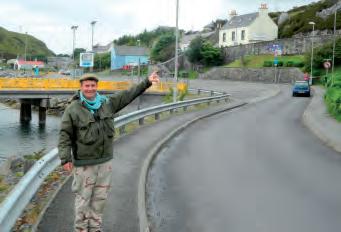
Mark Cocker points to where the lucky pair first saw the Needletail
that’s what I call a rarity!”), we immediately tried to relocate the bird, at first without success. As I didn’t have the Birdguides/RBA numbers on me, I called Steve Piotrowski, who kindly agreed to put the news out immediately (whilst recalling how much he’d enjoyed the Shetland bird in 1984). With no further sign of the bird, I soon had calls from Birdguides and RBA, as well as Tim Cleeves, whose first words were “how jammy are you two?” and he immediately set about re-arranging his travel plans, as he had been due to leave the islands the following day. After what seemed a long time, at 4.38pm we re-located the bird just SE of Tarbert, but still visible from the town. For the rest of the afternoon, the bird moved between that area (towards Loch Direcleit) and Tarbert town, with some five sightings, but proving hard to keep in view for more than 1-2 minutes at a time.
Returning the following morning, we found an anxiety (my proposed collective noun for birders who haven’t yet connected with their target) of fifteen to twenty birders gathered together half way between the town and the loch. Thinking we had a better chance at the top of the hill, closer to the loch, that is where we looked. After an anxious wait, the bird eventually appeared about 10.20am, triggering a stampede from those further down the hill. It then performed very well for the swelling numbers, at one point causing concern when it flew very close to an oncoming car on the loch-side road, in a strange foretaste of what was to come the following day. As Mark Cocker put it in his Guardian Country Diary of 8/7/13 ‘one friend [went] from gibbering anxiety to exultant delirium’ in seconds. At one breathtaking point, the bird passed within five or six metres of a few of us, prompting the comment that it felt a bit like being buzzed by a skua (such was the awesome power of the bird). In the afterglow of seeing one of his ‘most wanteds’ Tim Cleeves compared the bird to a small aerial orca!
The tragic end Having had great views, we headed to Stornoway and the west coast of Lewis. I had a couple of appreciative texts from those who had seen the bird, with the last at 15.25hrs, saying it had been ‘relocated further south’ after having gone off the radar for a couple of hours. That was the last we heard on 26th June, as we were out of mobile reception on the far west coast of Lewis, until the morning of 28th, when I picked up a text from Richard Rafe saying ‘Thanks for great bird – pity about ending’. At first it was hard to take in the news (as for so many others also), but then we were left with a deep sense of sadness that this fabulous bird had flown so far, to end up in a million to one collision with the only wind turbine in that area.
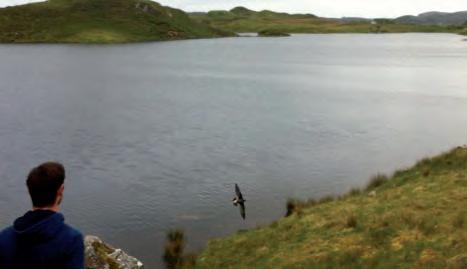
The sad story was widely covered, and made the front page of the Scottish Sun under the headline ‘Life’s a Twitch’ (upstaging both Gwyneth Paltrow and Andy Murray and prompting a statement on wind power from the Scottish Government!). Although the fact that such a supreme flier could still collide with a turbine does raise some worrying questions, in my view it should not trigger a knee-jerk anti-wind power reaction. Apart from great sadness at the bird’s tragic ending, I am left feeling very fortunate that we were simply in the right place at the right time, and to have been able to share the bird with those who were able to get there within 24 hours of our first report. Having been to south-west
Adam Gretton where the bird flew directly over them and they clinched its ID - or perhaps he’s hailing a taxi?










